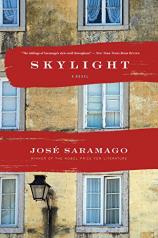Skylight
Review
Skylight
Anyone who has ever had trouble getting a novel published should take comfort in the case of José Saramago. In 1953, when he was 31 and still an aspiring novelist, Saramago submitted the manuscript of his novel SKYLIGHT to a publishing house in Portugal. He received no response. Saramago was so distraught over the publisher’s indifference that he didn’t write another novel for almost 25 years.
By 1989, Saramago was the celebrated author of THE STONE RAFT, THE HISTORY OF THE SIEGE OF LISBON, and (my choice for his best book) THE YEAR OF THE DEATH OF RICARDO REIS. Nine years later, the Swedish Academy would award him the Nobel Prize in Literature. According to Pilar del Río, Saramago’s widow and author of the preface to SKYLIGHT, the publisher who had ignored SKYLIGHT for 36 years called in 1989 and said, “It would be a great honor for us to publish this manuscript.” “Thank you, but no,” Saramago told them. He collected his manuscript, brought it home, and refused to allow its publication during his lifetime.
"The characters are fascinating and well-drawn, and the conflicts engaging.... If Saramago hadn’t been rebuffed, he might not have become the brilliant and wildly experimental polemicist of his later years."
His reason, del Río writes, was “that while a publishing house is clearly under no obligation to publish every manuscript it receives, it does have a duty to respond to the person waiting impatiently and even anxiously day after day, month after month.” Saramago refused the novel’s publication, he said, because he didn’t want to be reminded of the publisher’s bad manners.
The book is now available in English. Although SKYLIGHT doesn’t rank with Saramago’s greatest works, or even with his other posthumously published novel, RAISED FROM THE GROUND, it’s an entertaining work that shows the Saramago style in embryo: sly wit, Communist sympathies, and his colorful defense of atheism.
The setting is a rundown apartment complex in Lisbon a few years after the end of World War II. Almost 40 years before the director Richard Linklater used the same technique in his film Slackers, Saramago introduced the building’s residents by showing two people in conversation, then, when one walks away, we follow that character until he or she meets another, whereupon we follow that new character, and so on. This technique sets the breezy, offhand tone that Saramago maintains throughout.
The residents of the building include Silvestre, a cobbler given to philosophical musings, and his wife, Mariana, who decide to take in a lodger, Abel Nogueira, a drifter who goes from one job and residence to the next because he doesn’t “want to be trapped, and life is an octopus with many tentacles. It just takes one to trap a man”; a widow, Candida, her sister Amélia, and Candida’s adult daughters, Adriana and Isaura, who struggle in varying ways with their respective sexual identities; Caetano Cunha, a newspaper Linotype operator, and his wife Dona Justina, who still grieves over the death of their eight-year-old daughter, Matilde; a father, Emílio, who struggles to reconcile his love for his young son, Henriquinho, with a desire to get away from his family; and Dona Lídia, a 32-year-old kept woman, “her trump card being that sensual body of hers,” who uses her trump card to win the affection of businessman Paulino Morais and to encourage him to hire Maria Cláudia, the 19-year-old daughter of another couple in the building, but doesn’t foresee that Morais’ interest in Maria Cláudia may extend beyond business.
If you’ve read Saramago’s work before, you may be thinking that SKYLIGHT sounds like more of a soap opera than his more mature works. It is. The novel is more melodramatic than the books that followed. And Saramago had yet to figure out how to blend his themes into a narrative. Silvestre and Abel, for example, have long discussions about the evils of capitalism and the older man’s embrace of socialism, but these chats feel like pauses in the story rather than natural emergences from character and situation.
But none of that means the book is dull or deserved to be dismissed until its author was a more profitable commodity. As del Río muses, the book probably wasn’t published in the ’50s because of its bold subject matter --- Saramago deals frankly with such topics as lesbian desire --- and fear of retribution from the Salazar dictatorship. The characters are fascinating and well-drawn, and the conflicts engaging. Maybe that rude publisher did us all a favor. If Saramago hadn’t been rebuffed, he might not have become the brilliant and wildly experimental polemicist of his later years.
Reviewed by Michael Magras on December 19, 2014
Skylight
- Publication Date: November 3, 2015
- Genres: Fiction
- Paperback: 320 pages
- Publisher: Mariner Books
- ISBN-10: 0544570375
- ISBN-13: 9780544570375





